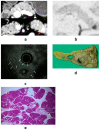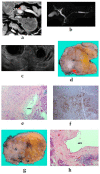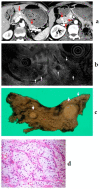Role of Endoscopic Ultrasound in the Diagnosis of Pancreatic Neuroendocrine Neoplasms
- PMID: 33672085
- PMCID: PMC7919683
- DOI: 10.3390/diagnostics11020316
Role of Endoscopic Ultrasound in the Diagnosis of Pancreatic Neuroendocrine Neoplasms
Abstract
Although pancreatic neuroendocrine neoplasms (PNENs) are relatively rare tumors, their number is increasing with advances in diagnostic imaging modalities. Even small lesions that are difficult to detect using computed tomography or magnetic resonance imaging can now be detected with endoscopic ultrasound (EUS). Contrast-enhanced EUS is useful, and not only diagnosis but also malignancy detection has become possible by evaluating the vascularity of tumors. Pathological diagnosis using EUS with fine-needle aspiration (EUS-FNA) is useful when diagnostic imaging is difficult. EUS-FNA can also be used to evaluate the grade of malignancy. Pooling the data of the studies that compared the PNENs grading between EUS-FNA samples and surgical specimens showed a concordance rate of 77.5% (κ-statistic = 0.65, 95% confidence interval = 0.59-0.71, p < 0.01). Stratified analysis for small tumor size (2 cm) showed that the concordance rate was 84.5% and the kappa correlation index was 0.59 (95% confidence interval = 0.43-0.74, p < 0.01). The evolution of ultrasound imaging technologies such as contrast-enhanced and elastography and the artificial intelligence that analyzes them, the evolution of needles, and genetic analysis, will further develop the diagnosis and treatment of PNENs in the future.
Keywords: endoscopic ultrasound; pancreatic neuroendocrine neoplasms; pancreatic tumor.
Conflict of interest statement
A.K. received honoraria as a lecture fee from Olympus Co., Tokyo, Japan. The sponsors had no role in the design, execution, interpretation, or writing of the study. The other authors declare no conflicts of interest relevant to this article.
Figures







Similar articles
-
Efficacy of endoscopic ultrasonography and endoscopic ultrasonography-guided fine-needle aspiration for the diagnosis and grading of pancreatic neuroendocrine tumors.Scand J Gastroenterol. 2016;51(2):245-52. doi: 10.3109/00365521.2015.1083050. Epub 2015 Sep 11. Scand J Gastroenterol. 2016. PMID: 26513346
-
Evaluation of Ki-67 index in EUS-FNA specimens for the assessment of malignancy risk in pancreatic neuroendocrine tumors.Endoscopy. 2014 Jan;46(1):32-8. doi: 10.1055/s-0033-1344958. Epub 2013 Nov 11. Endoscopy. 2014. PMID: 24218309
-
Diagnostic performance and factors influencing the accuracy of EUS-FNA of pancreatic neuroendocrine neoplasms.J Gastroenterol. 2016 Sep;51(9):923-30. doi: 10.1007/s00535-016-1164-6. Epub 2016 Jan 14. J Gastroenterol. 2016. PMID: 26768605 Free PMC article.
-
Endoscopic ultrasound in the evaluation of pancreatic neoplasms-solid and cystic: A review.World J Gastrointest Endosc. 2015 Apr 16;7(4):318-27. doi: 10.4253/wjge.v7.i4.318. World J Gastrointest Endosc. 2015. PMID: 25901210 Free PMC article. Review.
-
Diagnostic and Interventional Role of Endoscopic Ultrasonography for the Management of Pancreatic Neuroendocrine Neoplasms.J Clin Med. 2021 Jun 15;10(12):2638. doi: 10.3390/jcm10122638. J Clin Med. 2021. PMID: 34203922 Free PMC article. Review.
Cited by
-
Diagnostic work-up and advancement in the diagnosis of gastroenteropancreatic neuroendocrine neoplasms.Front Surg. 2023 Mar 6;10:1064145. doi: 10.3389/fsurg.2023.1064145. eCollection 2023. Front Surg. 2023. PMID: 36950054 Free PMC article. Review.
-
Hereditary Syndromes Associated with Pancreatic and Lung Neuroendocrine Tumors.Cancers (Basel). 2024 May 30;16(11):2075. doi: 10.3390/cancers16112075. Cancers (Basel). 2024. PMID: 38893191 Free PMC article. Review.
-
The role of needle-based confocal laser endomicroscopy in the diagnosis of pancreatic neuroendocrine tumors.Clin Endosc. 2024 May;57(3):393-401. doi: 10.5946/ce.2023.068. Epub 2023 Sep 12. Clin Endosc. 2024. PMID: 37743070 Free PMC article.
-
An Overview of Pancreatic Neuroendocrine Tumors and an Update on Endoscopic Techniques for Their Management.Curr Oncol. 2023 Aug 11;30(8):7566-7580. doi: 10.3390/curroncol30080549. Curr Oncol. 2023. PMID: 37623030 Free PMC article. Review.
-
Pancreatic Neuroendocrine Neoplasms: Classification and Novel Role of Endoscopic Ultrasound in Diagnosis and Treatment Personalization.United European Gastroenterol J. 2025 Feb;13(1):34-43. doi: 10.1002/ueg2.12710. Epub 2024 Nov 14. United European Gastroenterol J. 2025. PMID: 39540703 Free PMC article. Review.
References
-
- Katanuma A., Maguchi H., Osanai M., Takahashi K. The difference in the capability of delineation between convex and radial arrayed echoendoscope for pancreas and biliary tract; case reports from the standpoint of both convex and radial arrayed echoendoscope. Dig. Endosc. 2011;23:2–8. doi: 10.1111/j.1443-1661.2011.01131.x. - DOI - PubMed
-
- Kaneko M., Katanuma A., Maguchi H., Takahashi K., Osanai M., Yane K., Hashigo S., Harada R., Kato S., Kato R. Prospective, randomized, comparative study of delineation capability of radial scanning and curved linear array endoscopic ultrasound for the pancreaticobiliary region. Endosc. Int. Open. 2014;2:E160. doi: 10.1055/s-0034-1377384. - DOI - PMC - PubMed
-
- Puli S.R., Kalva N., Bechtold M.L., Pamulaparthy S.R., Cashman M.D., Estes N.C., Pearl R.H., Volmar F.-H., Dillon S., Shekleton M.F. Diagnostic accuracy of endoscopic ultrasound in pancreatic neuroendocrine tumors: A systematic review and meta analysis. World J. Gastroenterol. WJG. 2013;19:3678. doi: 10.3748/wjg.v19.i23.3678. - DOI - PMC - PubMed
-
- Manta R., Nardi E., Pagano N., Ricci C., Sica M., Castellani D., Bertani H., Piccoli M., Mullineris B., Tringali A. Pre-operative diagnosis of pancreatic neuroendocrine tumors with endoscopic ultrasonography and computed tomography in a large series. J. Gastrointestin. Liver Dis. 2016;25:317–321. doi: 10.15403/jgld.2014.1121.253.ned. - DOI - PubMed
Publication types
LinkOut - more resources
Full Text Sources
Other Literature Sources

